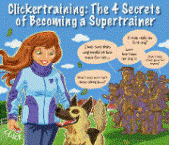Good Dog Training Advice
Get Fast & Simple Dog Training Tips to
Turn a Difficult Dog Into an Obedient Pet!
Training Your Beagle Not to Howl
Okay, The title might have been 'How to Train Your Beagle NOT to Howl'. But that would have been misleading. Beagles have been bred for hundreds of years as hunting dogs and their barks, bays, and howls are an important
part of that practice. Trying to train a Beagle to remain completely quiet all the time is akin to molding them to
become a cat. Not gonna happen. A bark is intended to alert the pack (whether human or canine) to danger, particularly the inherent danger of
being separated. If a puppy gets away from the pack, his vocalizations help the older dogs locate him. If the pack
or a member is threatened by another species, barks alert all members to focus on the threat. The sounds also
discourage the predator from carrying through with its plan. A bay is somewhere in between the two and, frankly, no one has ever figured out exactly what purpose it serves. Beagles simply seem to enjoy making their presence known to the world. A harsh sound, it may annoy you or the neighbors but Beagle owners know that baying is fun for the dog. They often do it even when not left alone and there are no distractions in the surroundings. All these different sounds and the events that tend to evoke them give pet owners clues about how to suppress
them. Keeping them close and showing lots of affection reduces the dog's need to seek it by baying. But, then, showing your Beagle love is not something you need to be encouraged to do. You won't be able to help yourself once you get him home.
| |
|


Discover the Secrets to Training Your Dog Or Puppy. Huge BONUSES for a limited time only!
Click here now...
|
http://GoodDogTrainingAdvice.com






